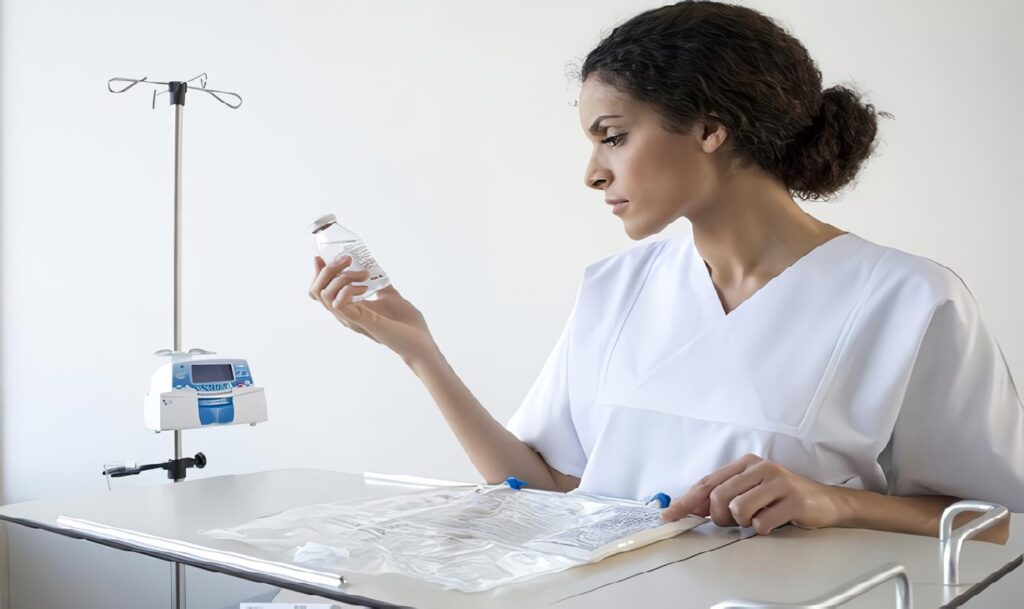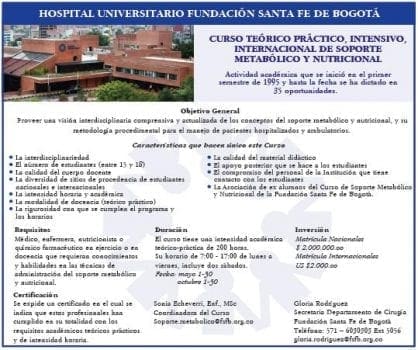Preparar en la farmacia en cabina de flujo laminar, usando técnica aséptica las mezclas de nutrición parenteral para 24 horas, entregarlas a los servicios debidamente rotuladas e indicar: componentes, relación, osmolaridad, goteo y número de la mezcla, con el fin de mantener la continuidad en su administración.(1,33,61) Categoría IB
Mantener la individualidad de la vía del catéter que está siendo utilizado para nutrición parenteral, a excepción de los lípidos que se pueden conectar en Y con aguja a la línea principal, estos se deben administrar en 24 horas y desechar el equipo.(1,33) Categoría II
6.3 Reservar la vía distal para administrar la nutrición parenteral cuando utilice un catéter de dos o tres luces.(1,33) Categoría IB
Utilizar bomba de infusión para administrar la nutrición parenteral (aminoácidos y dextrosa), cambie los equipos cada 48 horas, en paciente pediátrico y neonatal cada 24 horas. (33, 62) Categoría II
No utilizar buretroles, ni equipos tipo multiflo, ni llaves de tres vías en la línea utilizada para administrar nutrición parenteral.(33) Categoría II
Un frasco o bolsa de nutrición parenteral u otra solución no debe permanecer instalado por más de 24 horas. Mantener refrigerada a 4°C la mezcla que no se esté administrando. Retirarla del refrigerador 15 minutos antes de su infusión.(33) Categoría II
No reinstalar una solución que haya sido descontinuada o retirada.(33) Categoría II
No utilizar la luz del catéter de nutrición parenteral para la administración de medicamentos, ni realizar medidas de Presión Venosa Central o toma de muestras sanguíneas.(1,33) Categoría II
En paciente pediátricos y neonatales con catéteres unilumen y sin vía de acceso periférico disponible suspenda la nutrición, limpie el sitio de administración de medicamentos del equipo de infusión, irrigue con solución salina normal, administre el medicamento lentamente o a través de un buretrol e irrigue nuevamente con solución salina normal. Categoría II
Retirar el catéter utilizado para administrar nutrición parenteral sólo por orden del Servicio de Soporte Metabólico y Nutricional.(33) Categoría II
Si el paciente tiene un catéter implantado o un catéter para hemodiálisis se podrán utilizar para administrar nutrición parenteral, sólo de común acuerdo con la sección de Oncología y Nefrología respectivamente.(33) Categoría II
Utilizar filtros de 0,22 micras cuando se administre nutrición parenteral que contenga fosfato y calcio. Cambiar el filtro con los equipos cada 48 horas (63,65) Categoría IB
Utilizar filtros de 1,2 micras cuando la nutrición parenteral contenga lípidos. Cambiar el filtro cada 24 horas.(63,65) Categoría IB
Observar la mezcla parenteral que se está administrando en busca de precipitaciones y turbidez.(33) Categoría II
El SSMN ordenará cambiar la mezcla que se está administrando, sólo en situaciones especiales y bajo condiciones estrictamente necesarias.(33) Categoría II
Referencias Bibliográficas
1. Pearson ML. Hospital Infection Control Practices Advisory Commitee. Centers for Disease Control and Prevention. Guidehes for prevention of intravascular device-related infections, 1996
2. Pimiento S, Patiño JF, Escaiión J, Londoño E. Manejo del catéter venoso central en la Fundación Santa Fe de Bogotá. En: Anuario del Comité de Investigaciones y Publicaciones Biomédicas, Fundación Santa Fe de Bogotá, Ed. amc, 1990:29-35
3. Arnow PM, Quimosing EM. Consequences of Intravascular Catheter Sepsis. Clin Infect Dis 16:778-84,1993
4. Pimiento S, et al. Control de la cateterización venosa central en la Fundación Santa Fe de Bogotá 1991-1999. Comunicación interna preluninar. Febrero 2000
5. Pimiento S, et al. Control de la cateterización arterial en la Fundación Santa Fe de Bogotá. En: Anuario del Comité de Investigaciones y Publicaciones Biomédicas, Fundación Santa Fe de Bogotá,
6. Bozzem F. Central venous catheter sepsis. Surgery, Gynecology & Obstetrics,161:293-301, 1985
7. Gosbell IB. Central venous catheter-related sepsis: epidemiology, pathogenesis, diagnosis, treatment and prevention. Intensive Care World 11 (2):54-58, 1994
8. Kruse JA, Shah NJ. Detection and Prevention of Central Venous Catheter-Related Infections. NCP 8:163-170, 1993
9. Maki DG. Yes, Virginia, asejtic technique is very important: maximal barrier precautions unng insertlon reduce the risk of central venous catheter-related bacteremia. Infect Control Hosp Epidemiol;l5:227-230, 1994
10. Patiño JF. Metabolismo, Nutrición y Shock en el paciente Q.inírgico. Tercera Edición. Fundación Lucía Patiño Osorio. Bogotá, 1985,
11. Raad I, et al. Prevention of Central Venous catheter-related infections by using maximal sterile barrier precautions during insertion. Infect Control Hosp Epidemioll5:231-238, 1994
12. Ryder M. Device selection: A critical strategy in the reduction of catheter-related complications. Nutrition 12(2):143-145, 1996
13. Lee RB, Buckner M, Sharp KVCI Do multi-lumen catheters increase central venous catheter sepsis compared to single catheters?. J Trauma 28:1472-5, 1988
14. Farkas JC, et al. Single-versus triple-lumen central catheter-related seosis: a orosoective randomized studv in a criticallv ill population Am J Med 93:277-82, 1992
15. Clark-Christoff N, Watters VA, Sparks W, Snyder P, Grant JP. Use of triple-lumen subclavian catheters for administration of total parenteral nutrition. J Parenter Enteral Nutr 16:403-7, 1992
16. Pimiento ‘ S, Escallón J, Celis E, Navarro MC, Holguín F. Accesos venosos centrales en Dacientes con trauma múltide. Panam J Trauma 6:26-33, 1995
17. Mermel LA. Stolz SM. Maki DG. Surface antimicrobial activity of heparin-bonded andantiseptic impregnated vascular catheter;. J Infect Dis 167:920-4, 1993
18. Mermel LA, McCormick RD, S ringman SR, Maki DG. The pathogenesis and epidemiology olcatheter-related infection with pulmonary artery Swan- Ganz catheters: a prospective study utilizing molecular subtyping. Am J Med 9l(supp 3B):170S-205S, 1991
19. Maki DG, Stolz SS, Wheeler S, Mermel LA. A rospective, randomized trial of gauze and two polyurethane gessings for site care of pulmonary artery catheters: impiications for catheter management. Crit Care Med 22:1729-27, 1992
20. Rello J, Coll P, Net A, Prats G. Infection of pulmonary artery catheters. Epidemiology characteristics and multivariate analysis of risk factors. Chest 103:132-6, 1993
21. Senagore A, Waller JD, Bonneii BW, Bursch LR, Scholter DJ. Puimonary artery catheterization: a prospective study of interna1 jugular and subclavian a proaches. Crit Care Med 15:35-7, 1987
22. Echeverri de Pimiento { et al. Análisis epidemiológco de 1825 catéteres de arteria pulmonar en la Fundación Santa Fe de Bogotá. En: Anuario del Centro deEstudios e Información en Salud, 1997. Editado por: MC. Granados, JC. González, Llinás A,, Fundación Santa Fe de Bogotá, 1998, p 65
23. Buckley CJ, Lee SD. Placement of vascular access devices for parenteral nutrition. NCP 14194-201, 1999
24. Groeger JS, Lucas AB, Thaler HT, et al. Infectious morbidity associated with long-term use ofvenous access devices in patients with cancer. Ann Intem Med 119:1168-74, 1993
25. Ryder M. The future of vascular access: will the benefits be worth the risk? (Editorial). NCP: 14165-9, 1999
26. Krzywda EA, Andris DA, Edmiston CA. Catheter infections: diagnosis, etiology, treatment and prevention. NCP 14178-190, 1999
27. Crocker KS, Devereaux GB, Ashmore DL, Coker MH. Clinical evaluation of elastometric hdrogel peripheral catheters during home infusion therapy. J Intravenous Nurs.l3:89-97, 1990
28. Jarvis WR, Cookson ST, Robles B. Prevention of nosocomial bloodstream Infections: a national and international priority. Infect Control HOSF ,Epide@ol 17:272-5, 1996
29. Linden PK. Chca unphcauons of nosocomial gram-positive bacteremia and SuDerimDosed antimicrobial resistance. Am 1 Med 104(5 A): 24S-3%, 19bS
30. Raad 1. Costerton W. Sabharwal U. et al. Ultrastructural analvsis of indwelling vascular catheters: a quantitative relationihip between luminal colonization and duration of placement. J Infect Dis 168:400-7, 1993
31. Winkler MF, Watkins CK, Albina JE. Vascular access devices: one institution’s teaching. NCP 14205-7, 1999
32. Seto WH, Ching TY, Yuen KY, Chu YB, Seto WL. The enhancement of infection control in-service education by ward opinion leader. Am J C h Pathol 19:86-91, 1989
33. Echeverri de Pimiento S, Escallón J. Guía para el manejo del catéter venoso central. Fundación Santa Fe de Bogotá, 1988-1999
34. Parsa MH, Shoemaker WC. Acceso intravascular y mantenimiento prolongado de catéteres. En: Tratado de Medicina Cntica y Terapia Intensiva. Shoemaker WC. Ayres SM, Grenvick A, Holbrook PR. Tercera edición, Ed. Médica Panamericana. 1996, p 239
35. McIntosh BB, Dulchavsky SA. Peripheral vascular cutdown. Procedures in ICU. Critical Care Clinics 8(4):907-818, 1992
36. Harden JL, Kemp L, -tallo J. Femoral catheters increase risk of infection in total parenteral nutrition patients. NCP 1060-66, 1995
37. Collins E, et al. Care of central venous catheters for totalparenteral nutrition. NCP 11:109-115, 1996
38. McCarthy MC, et al. Prospective evaluation of single and triple lumen catheters in total parenteral nutrition. JPEN 11:259-262, 1987
39. Olson ME, et al. Evaluation of strategies for central venous catheter replacement. Critical Care Medicine 20(6):797-804,1992
40. Ullman RF, et al. Colonization and bacteremia related to duration of triple-lumen intravascular catheter placement. Am J Infect Control 18:201-207,1990
41. Ma TY, Yoshinaka R; Banaag A, et al. TPN via multilumen catheters does not increase the risk of catheter-related sepsis: a randomized prospective study. Clin Infect Dis 27:500-3, 1998
42. Daschner FD. The transmission of infections in hospitals by staff carriers, methods of prevention and control. Infect Control 697-8, 1985
43. Simmons B, Bryant J, Neiman K, et al. The role of handwashing in prevention of endemic intensive care unit infections. Infect Control Hosp Epidemiol 11:589-94, 1990
44. Maki DG, Ringer M, Alvardo CJ. Prospective randomized trial of povidone-iodine, alcohol, and chlorhexidme for revention of infection associated with central venous and arteriJcatheters. Lancet 338:339-43, 1991
45. Strand CL, Wausbort RR, Sturmann K. Effect of iodophor vs iodine tinture skin preparations on blood culture contamination rate. JAMA 269:1004-6, 1993
46. Rannem T, et al. Catheter-related se sis in long-term parenteral nutrition with Broviac catheters. x n evaluation of different disinfectants. Clinical Nutrition 9:131-6, 1990
47. Maki DG, McCormack KN. Defatting catheter insertion sites in total parenteral nutrition is no value as an infection control measure. Controiied chcal trial. Am J Med 833333-40, 1987
48. Kehr J. Sepsis relacionada a catéter en nutrición parenteral central. Rev CM Infect 16(1):39-45, 1999
49. Raad 1, Baba M, Bodey GP. Diagnosis of catheter-related infections: role of the surveiilance and targeted quantitative skin cultures. C h Infect Dis 20:593-7,1995
50. Maki DG, Ringer M. Evaluation of dressing regimens for prevention of infection with peripheral intravenous catheters. Gauze, a transparent polyurethane dressing, and an iodophortransparent dressing. JAMA 258:2396-403, 1987
51. Hoffmann KK, Weber DJ, Samsa GP, Rutala WA. Transparent polyurethane film as an intravenous catheter dressing: a metaanalysis of the infection risks. J A d 267:2072-6, 1992
52. Centers for Disease Control and Prevention. Update: universal precautions for revention of transmission of HIV, Hepatitis B, and other bloogborne pathogens in healthcare settings MMWR 24:377-82, 308,1988
53. Scott N, Grant J. An evaluation of triple-lumen catheter infections using a guidewire exchange technique. Journal of Trauma 30(6):706-712, 1990
54. Conly JM, Grieves K, Peters B. A prospective, randomized study comparing transparent and dry gauze dressing for central venous catheters. Infect Dis 159:310-319, 1989
55. Wormser GP, Onorato IM, Preminger TJ, Culver D, Martone WJ. Sensivity and specificity of blood cultures obtained through intravascular catheters. Crit Care Med 18152-6, 1990
56. Cobb DK. et al. A controlled trial of scheduled redacement of central venous and pulmonary artery catheters. N’ Engl J Med 327:1062-8. 1992
57. Eyer S, Brummitt C, Crosley K, Siegel R, Cerra E Catheterrelated semis: DrosDective, randomized studv of three different methods ‘of 16ng-Lerm catheter maintenance. Crit Care Med 18:1073-9. 1990
58. Garrelts JC. White clot syndrome and trombocytopenia: reasons to abandon heparin IV lock flush solution. C h Pharm 11:797- 9, 1992
59. Goode CJ, Titler M, Rakel B, et al. A meta-analysis of effects of heparin flush and salme flush. Nur Res; 40:324-330, 1991
60. Tafuro P, et al. Comparison of blood cultures obtained simultaneóusly by venopuncture and from vascular lines. J Hosp Infect 7:283-8, 1986
61. ThomDson B. et al. Infection Control of Parenteral Nutrition Solutihns. NCP; 6:44-54, 1991
62. Dangio RG. Riechers KC. Gilsforf RB. Constantino TM. Effect of tKe mode of iipid administration ‘on parenterd nutrition related infections. Ann Pharmacother; 26:14-17, 1992
63. McKinnon BT. FDA safety Alert: Hazzards of precipitation associated with parenteral nutrition NCP 11:59-65, 1996
64. Ronchera-Oms CL, Jiménez NV, Peidro J. Stability of parenteral nutrition admixtures containing organic phosphates. Ciinical Nutrition 14:373-380, 1995
65. Mckav MW. Fitzcrerald KA, Tackson D. The solubilitv of Calcium and Phosphate-in two sGciality aminoac Fitzcrerald KA, Tackson D. The solubilitv of Calcium and Phosphate-in two sGciality aminoacid solution. JPEN 20(1):63-66, 1996




